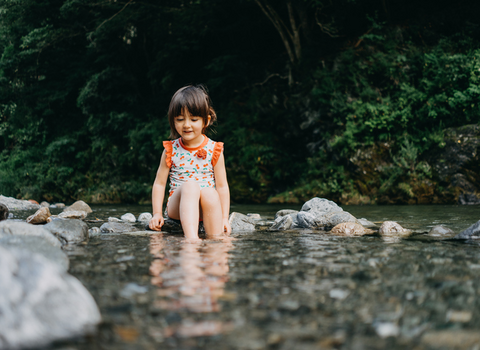Ten years ago, I remember taking my two young children down to the River Wye/Afon Gwy in Rhayader to show them the aquatic invertebrates in the river. As a local entomologist, I was keen to involve my children in discovering and learning more about the hidden world beneath the water. So, with wellies on, we carried water nets, trays, collecting pots and a couple of identification guide books to the river’s edge. Once there, I demonstrated how to collect the bugs by ‘kick-sampling’ into the stream bed stones to dislodge the bugs holding onto them, although I did get one wellie full of cold water, so that lost me some credentials! The kids then had a go, and after one or two initial cautious kick samples, they loved it! They carefully tipped the nets full of pebbles and bugs into the white trays full of clear river water and we watched the sediment settle quickly before my daughter pointed and said ‘there’s one’! It was a large mayfly nymph, a so-called stone-clinging type of mayfly called Ecdyonurus.
Monitoring water quality in the Wye catchment
(c) Ross Hoddinott /2020VISION
These are splendid beasts with their body flattened top to bottom, being literally streamlined to avoid being swept downstream, with widely spread strong legs marked with striking dark stripes for holding on to the underside of submerged stones, large eyes, and three very long tails which they spread out. We counted over 20 of these stone-clinging mayflies in our trays, of different sizes. We also caught many ‘swimming’ mayflies in the family Baetidae, which are more narrowed cylindrical creatures than the stone-clingers and which actively swim quickly through the water. The children had great fun gently persuading these to dash through our tray. Stoneflies were also numerous, being very different to mayflies in having only two tails rather than three, and wriggle snakelike when swimming. We also took a variety of caddis fly ‘cases’, these insects being well known for building sand grain, tiny stone, or plant material cases around their bodies for protection, some of which drag them around like snails do with their shells, in a caravan fashion, whilst other types of caddis flies stick these cases permanently onto rocks in the river, just like underwater houses. After feeding and growing through the year, when the young caddis flies have grown large enough, they seal themselves into this case, turn partially into a chrysalis form over a couple of weeks, before emerging and either crawling to the river’s edge or swimming to the waters surface where they then quickly spilt open the swimming chrysalis case and emerge as a fully winged adult caddis fly. Adults then mate, and females return to the waters edge to lay eggs. We also saw many freshwaters shrimps, diving beetles, and even a leech!
Mayflies, stoneflies and caddis flies are collectively known as ‘river flies’ as they are all freshwater animals normally common in our rivers and streams and are the very best indicators of natural water quality. Due to the River Wye’s significant wildlife value, including for otter, fish such as salmon, aquatic plants especially dense water-crowfoot beds, and invertebrates, to name but a few, the catchment is designated a Special Area of Conservation (SAC).
In summer 2021, due to increasing water quality concerns across the River Wye catchment, local groups of people were being initiated who wanted to help address these issues. Citizen Science groups including the Friends of the Upper Wye (FOUW) and Friends of the Lugg (FUL), with close involvement from the Radnorshire Wildlife Trust (RWT) and the Council for the Protection of Rural Wales (CPRW), were starting to set up and train volunteers, with essential support from Cardiff University who provided all the methodology and online resources including training materials and videos.
Through RWT, I was involved in helping train the FUL Citizen Scientists group to the methods involved and commitments in weekly sampling, having so far undertaken five outdoor training days, with over 50 volunteers now trained. Each day focused on how to carry out practical sampling, using test equipment to take 5 measurements, including electrical conductivity, temperature, phosphate, nitrate and turbidity readings, as well as covering risk assessment, and recording and data entry using a dedicated Epicollect app. The group have also purchased more accurate electronic Hanna phosphate checkers, with 10 volunteers also now trained in their use. To date, Citizens Scientists are currently sampling at over 35 locations across the upper River Lugg catchment in Radnorshire.
As this project involves a growing number of local volunteers, funding from various sources which is ongoing, has been essential in buying all the sampling and test equipment needed to continue.
This is part of a larger citizen science project to investigate water quality in the River Wye catchment, working with similar sub-catchment groups, namely Friends of the Upper Wye and Wye Salmon Association (WSA). Recently, newly formed groups include Friends of the Lower Wye covering Monmouthshire, and Campaign for the Protection of Rural England (CPRE) in the Herefordshire area.
The objectives of the water quality monitoring are to gather data using set protocols and shared methods across all the catchment groups, which contributes towards a shared database that can be collectively analysed, and to improve wider understanding of trends and patterns in water quality across the River Wye catchment including identifying potential water quality issues and providing the evidence required to drive action to address them.
All this Citizen Science monitoring undertaken by the sub-catchment groups has helped to massively raise public awareness of the issues of water quality, with much recent press coverage, not just within Wales but across the UK.
Phil Ward – Wildlife Volunteers Officer (Green Connections), Radnorshire Wildlife Trust

